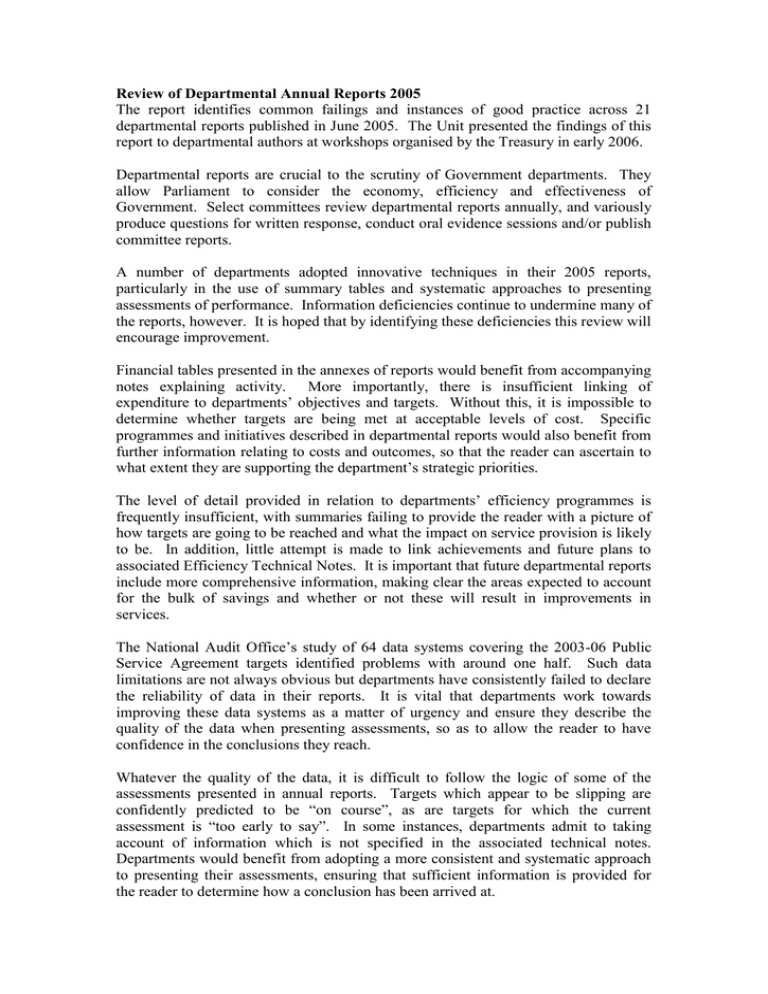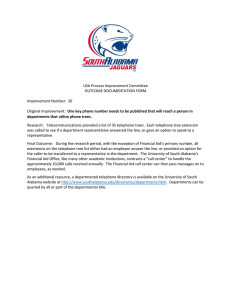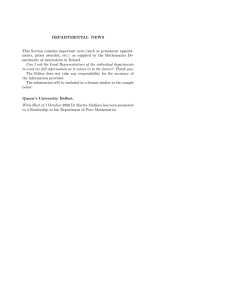Review of Departmental Annual Reports 2005
advertisement

Review of Departmental Annual Reports 2005 The report identifies common failings and instances of good practice across 21 departmental reports published in June 2005. The Unit presented the findings of this report to departmental authors at workshops organised by the Treasury in early 2006. Departmental reports are crucial to the scrutiny of Government departments. They allow Parliament to consider the economy, efficiency and effectiveness of Government. Select committees review departmental reports annually, and variously produce questions for written response, conduct oral evidence sessions and/or publish committee reports. A number of departments adopted innovative techniques in their 2005 reports, particularly in the use of summary tables and systematic approaches to presenting assessments of performance. Information deficiencies continue to undermine many of the reports, however. It is hoped that by identifying these deficiencies this review will encourage improvement. Financial tables presented in the annexes of reports would benefit from accompanying notes explaining activity. More importantly, there is insufficient linking of expenditure to departments’ objectives and targets. Without this, it is impossible to determine whether targets are being met at acceptable levels of cost. Specific programmes and initiatives described in departmental reports would also benefit from further information relating to costs and outcomes, so that the reader can ascertain to what extent they are supporting the department’s strategic priorities. The level of detail provided in relation to departments’ efficiency programmes is frequently insufficient, with summaries failing to provide the reader with a picture of how targets are going to be reached and what the impact on service provision is likely to be. In addition, little attempt is made to link achievements and future plans to associated Efficiency Technical Notes. It is important that future departmental reports include more comprehensive information, making clear the areas expected to account for the bulk of savings and whether or not these will result in improvements in services. The National Audit Office’s study of 64 data systems covering the 2003-06 Public Service Agreement targets identified problems with around one half. Such data limitations are not always obvious but departments have consistently failed to declare the reliability of data in their reports. It is vital that departments work towards improving these data systems as a matter of urgency and ensure they describe the quality of the data when presenting assessments, so as to allow the reader to have confidence in the conclusions they reach. Whatever the quality of the data, it is difficult to follow the logic of some of the assessments presented in annual reports. Targets which appear to be slipping are confidently predicted to be “on course”, as are targets for which the current assessment is “too early to say”. In some instances, departments admit to taking account of information which is not specified in the associated technical notes. Departments would benefit from adopting a more consistent and systematic approach to presenting their assessments, ensuring that sufficient information is provided for the reader to determine how a conclusion has been arrived at. Not enough space is given to discussion of past performance in some of the reports, particularly where a target is assessed as being subject to “slippage”. Without such information the reader cannot determine what problems have been encountered and to what extent these are within the responsibility of the department. Similarly, some departments fail to provide any details of future initiatives designed to rectify this position. Although there was a shift towards outcome-based directional targets under the 2004 Spending Review, many input-focussed and absolute ones remain. While it is not for this report to comment on the relative merits of differently designed targets, it is clear that the inconsistency which is inherent in such a mixed approach risks creating confused messages about the Government’s priorities. The failure to provide any explanation in departmental reports of how targets have been decided upon means that the reader can only guess at departments’ thinking. It remains difficult in many instances to map targets to objectives, and to reconcile objectives over time. Provision of fuller information regarding target setting and the use of summary reconciliation tables would help reduce such problems. Going forward, departments should, as a minimum, ensure that they are fully compliant with Treasury guidance on the content and presentation of annual reports. Beyond this, it is important that each department produces annual reports which provide Parliament and the public with sufficiently full and accessible information to determine how the department is progressing against its strategic objectives, what action it is taking to further improve performance and how much these processes are costing. Only armed with these details can the reader hope to assess the economy, efficiency and effectiveness of the department. Having considered the full range of published departmental reports and identified weaknesses and strengths, the Scrutiny Unit believes future reports could and should include: Notes accompanying core financial tables to explain trends and unusual movements; Direct linking of expenditure/resources to targets/outcomes, both at objective level and in relation to individual initiatives; Comprehensive discussion of progress on efficiency programmes, including explanation of where major savings are anticipated and the likely impact on services; Full information regarding the quality of data used in assessing targets, with limitations clearly set out; Consistently expressed assessments which follow logically from the information provided; Details of any information which is outside of measures described in PSA technical notes; Full commentary on past performance, with explanations for failures to meet targets, and discussion of future initiatives designed to improve performance; and Some form of reconciliation of current objectives and targets, and of targets over time. Many of these improvements simply require departments to rethink the design of their reports and take more account of readers’ requirements. Other improvements are more likely to flow if the Treasury reforms parts of its guidance in relation to departmental reports. The Scrutiny Unit proposes two key changes: First, reporting resources by objective should be made mandatory in the core tables, so as to prevent departments interpreting the existing requirement to explain what the department is spending its money on in differing ways; Second, each report should be required to include a summary table which details total delivered efficiencies and reconciles these with the planned savings set out in the Efficiency Technical Note.


